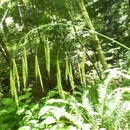More info for the terms:
cover,
forest,
frequency,
prescribed fire,
presence,
shrub,
underburnSeveral studies of the effects of logging and burning include
information on Columbia brome response.
In a ponderosa pine (Pinus ponderosa) forest in northern Idaho, Columbia
brome decreased after fire [
3]. See FIRE CASE STUDY.
In seral shrub communities in the cedar-hemlock (Thuja-Tsuga spp.) zone
of northern Idaho, Columbia brome was significantly more frequent in
unburned stands than in broadcast burned stands. Presence of Columbia
brome in stands with different disturbance histories was as follows [
31]:
Percent Frequency
Closed stand, no disturbance 47
Logged, no Burn 38
Logged, piled and burned 32
Single broadcast burn 16
Multiple broadcast burns 21
Columbia brome was considered neutral with respect to fire in mixed
forests of Rocky Mountain Douglas-fir, grand fir, and western redcedar
(Thuja plicata) on the Priest River Experimental Forest in northern
Idaho. Columbia brome was present in plots that had been logged and
then given treatments of no fire, a moist fuels underburn in June 1989,
or a dry fuels underburn in September 1989. Pretreatment cover
estimates were made during the summer before logging began.
Posttreatment cover estimates were made for both fire and no fire units
in the summer of the year after the fires. Columbia brome was present
with the following percent cover [
38]:
Moist Fuels Dry Fuels
No Fire Fire Fire
pre- post- pre- post- pre- post-
logging fire logging fire logging fire
1.9 0.2 1.7 0.2 1.5 0.1
Vegetation in plots on burned slash piles in the Mission Mountains in
northwestern Montana was compared with vegetation in plots adjacent to
the slash piles which had not burned. Each logging site had 40 burned
and 40 unburned quadrats. The slash piles had been burned 2 to 15 years
(average 8.8 years) before evaluation. Average frequency of Columbia
brome was 5.6 percent higher on burned plots than on unburned plots, but
this change was not statistically significant; Columbia brome was
considered neutral with respect to fire [
44].
Columbia brome in the Swan Valley of northwestern Montana was apparently
favored in mixed coniferous stands which had been logged, logged and
burned, or burned only. Columbia brome occurred in undisturbed forests
with presence of 36 percent and cover of 2 percent. In treated plots
(all treatments considered together), Columbia brome had presence of 46
percent and cover of 3 percent. Percent presence and average percent
cover were based on plots of occurrence [
12].
Columbia brome was also favored by disturbance in grand fir/pachistima
and grand fir/twinflower (Linnaea borealis) forests in the Blue
Mountains of northeastern Oregon. Stands were logged and broadcast
burned to reduce slash. Columbia brome germination and establishment
was enhanced in those areas with deeply churned soils and heavily burned
spots [
9].
For further information on Columbia brome response to fire in a ponderosa
pine community, see
Fire Case Studies. From the same Fire Study, the Research
Project Summary
Understory recovery after low- and high-intensity fires in northern
Idaho ponderosa pine forests provides information on prescribed fire and
postfire response of Columbia brome and other ponderosa pine plant community
associates.

